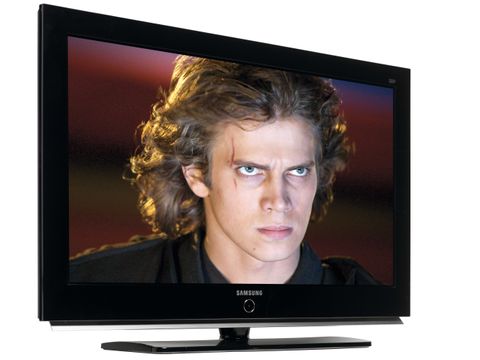TechRadar Verdict
A beautiful, attractively priced TV thats just a refinement away from excellence
Pros
- +
Picture quality is good
Decent price
Cons
- -
No digital tuner
Why you can trust TechRadar
To be honest, Samsung has taken longer than we'd expected to deliver its first full HD LCD TV. But now that duck has finally been broken in the shape of the 40in LE-40F71B - and a very lovely shape it is too. In fact, with its high-gloss black finish, curved edges and angled silvery strip along the bottom edge, it's hard to think of an LCD TV that's more attractive.
Fittingly for a full HD TV - that's a TV with a 1920 x 1080 resolution that can accept the 1080p hi-def video format - the LE-40F71B's connections include two HDMIs, both capable of taking 1080p, as well as the 1080i and 720p hi-def formats. This is on top of a component video input (an analogue hi-def connection), a PC video input, slots for viewing digital photos off memory cards and USB devices, and all the usual standard-def offerings.
However, there's a surprising hitch: the LE-40F71B doesn't have a digital tuner. This seems bizarre for such a forward-thinking TV, especially as practically every other Samsung TV has one. Our LE-40F71B review sample also blots its copy book by applying overscan to 1,080-line sources rather than showing them on a 1:1 pixel basis.
However, Samsung has produced a simple firmware upgrade for the LE-40F71Bs that introduces a 1:1 option. Call 0870 7267864 to find out more.
The LE-40F71B also carries Samsung's Digital Natural Image engine (DNIe), a picture processing system that works on boosting colour tones and saturation, black levels, sharpness and motion handling among other things. Plus it's built with a new wide colour gamut technology to deliver a greater chunk of the natural colour spectrum than most rival LCD TVs. Finally there's an automatic backlight adjuster that can reduce the picture's brightness during dark scenes to produce a massive claimed contrast ratio of 6000:1.
After spending a few crucial moments toning down the LE-40F71B's crazily aggressive factory presets, the TV proves to be a good, occasionally great, performer.
Quick on colour
Not surprisingly for a full HD set it's at its best with hi-def material, such as a recording of The Brothers Grimm from Sky HD. The 1920 x 1080 pixel count helps the Samsung deliver superb sharpness, clarity and texture during highly detailed scenes like those where the Brothers first take on the 'witch'. Colourful scenes like the girl in the red coat's charge through the forest, meanwhile, look amazingly vibrant thanks to the Samsung's wide colour response and solid - if not exactly inspired - black levels.
We also appreciated the lack of motion smearing evident during the film's action scenes and kinetic camera work, and the way the picture retains its qualities even if watched from a very wide viewing angle.
On the downside, the wide colour gamut technology occasionally goes a touch far, making one or two hues look slightly unnatural. Also, the set's standard-def pictures look rather softer than we'd like.
On top of that, the sound from the speakers hidden above that angled silver strip don't have enough power or aggression to drive soundtracks out with any potency.
These problems - along with the absent digital tuner - certainly don't stop the LE-40F71B from being a good TV. But they do prevent it from being a great one.
Tech.co.uk was the former name of TechRadar.com. Its staff were at the forefront of the digital publishing revolution, and spearheaded the move to bring consumer technology journalism to its natural home – online. Many of the current TechRadar staff started life a Tech.co.uk staff writer, covering everything from the emerging smartphone market to the evolving market of personal computers. Think of it as the building blocks of the TechRadar you love today.

